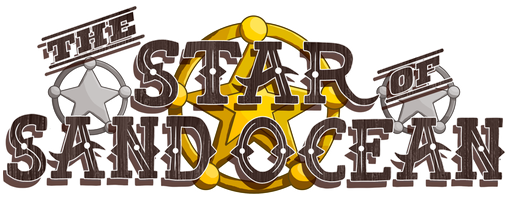
Story Paraphernalia
Take a look at important story things (for a lack of a better term), whether they be tangible or nontangible.
Cajiosas
In Sand Ocean, people typically keep small wooden boxes in their homes, filled with memorabilia of ones they love - whether it be a family member, a friend, or even a lover. These small mementos can be anything from photos and letters to pieces of jewelry or gems, or other small items that belonged to the person at some moment in time, and had been given to the person who owns the box.
Nearly every household has at least one cajiosa, most of them being designated to those who have passed away, especially of family members. However, only two cajiosas are prominent in the story, that being the ones belonging to Moe and Torito. Moe’s cajiosa is one that he dedicated to his mother, that generally belonged to the whole Clamson family, but took it with him when he moved out of Resshi Lake and away from his father. Torito’s cajiosa seems to be designated to a special someone, but he doesn’t share that information with anyone, and seems to be willing to keep it a secret to his grave.
Shiro also has his own cajiosa, dedicated to his late mother. However, it's not as prevalent as either Moe's or Torito's.
The Doctor's Cart
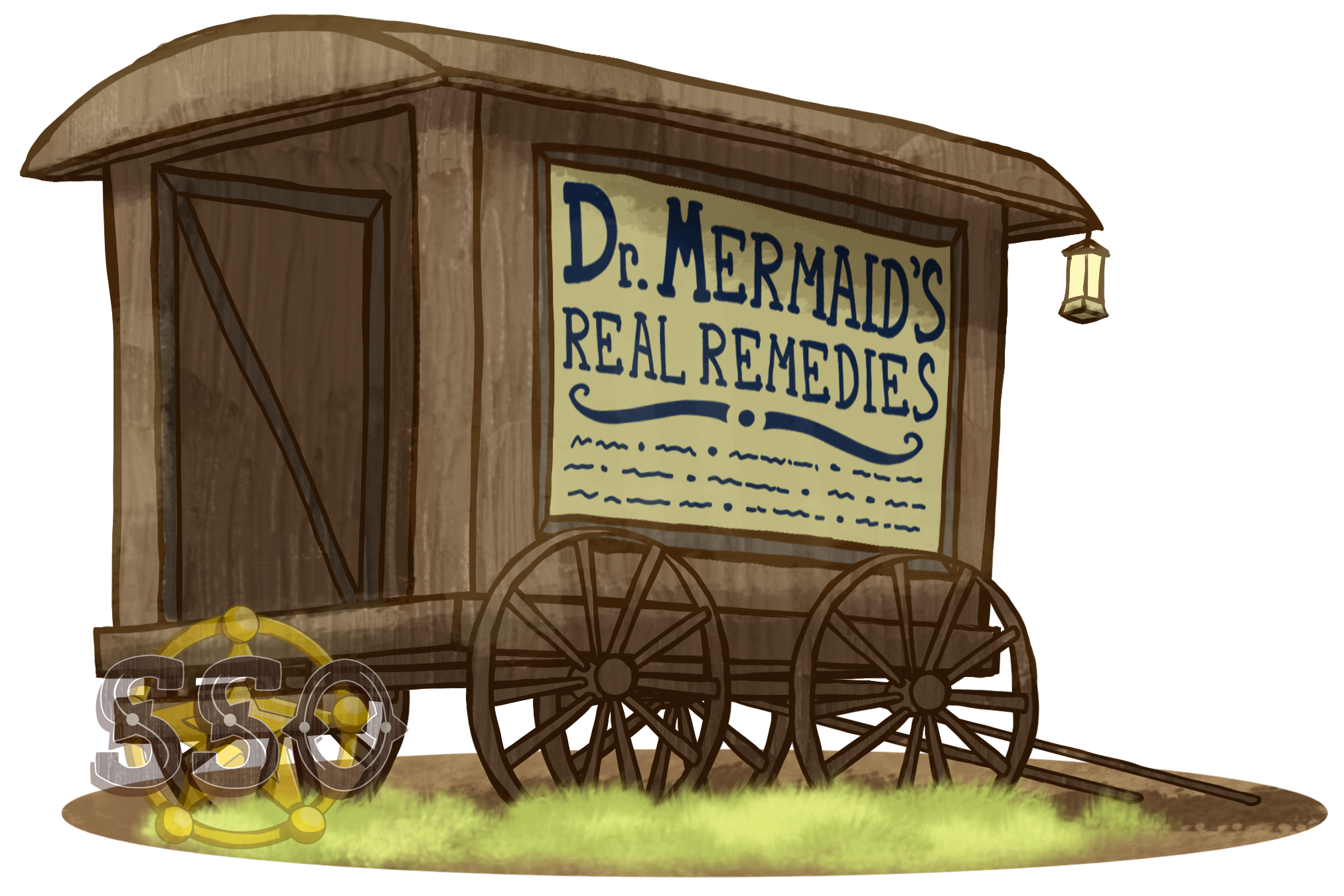
Health and medicinal practices were much different back then versus today. One of the main things was that the doctors usually performed examinations in the patient’s homes and not in a common office - or if they did that it would be the doctor’s own home, not a separate establishment for the sole purpose of treating ailments. Because doctors traveled to homes, they were very limited in what they could carry in their saddlebags to give to the patient to treat them with, which usually resulted in poor treatment.
Also common were medicine carts and “fake doctors” that often sold “elixirs” that were said to cure anything and everything, charging a high price to rip unsuspecting people off. These fake doctors would usually put on what were called “medicine shows” where they would gain a crowd of passersby and advertise how good their elixir worked, oftentimes asking for a volunteer from the crowd to demonstrate this. These shows would also be classified as a form of entertainment as well, despite how misleading the information is that’s given to the crowd.
The doctor in the South Side, Mermaid, has her own cart to carry her own supplies so she has full flexibility in her treatments. And one thing is for sure is that Mermaid ain’t no fake, she’s the real deal!
Guns

There is absolutely no doubt that guns had one of the most important influences to the culture and livelihood of the Old West. Nowadays, these guns are popular among avid collectors of antiques and memorabilia alike. While there were many more models of guns available during the time period of the Old West, people in The Star of Sand Ocean mainly utilize five different guns: the Derringer, the Colt single-action army revolver, the Colt Paterson revolver, the Winchester 1873 rifle, and the Sharps rifle. Because if I actually had to keep track of all the bajillion different kinds of guns that were out there at that time, I would go insane.
The guns arranged in the image are as follows: top to bottom, left to right.
The Derringer is an extremely small handgun, measuring at about 7 inches in total length and weighing 2 pounds. This small gun served as a well-sought-after gun by regular civilians and women for its size, as well as its ability to be easily concealed in a pocket, stocking, or within other articles of clothing. With its size comes a short effective shooting range of about 3-8 yards.
The Colt single-action army is a revolver that measures at roughly 10 inches in total length and weighs about 2.3 pounds. Aside from the Winchester 1873, the Colt army revolver was one of the most popular guns in the time of the Wild West, being fairly popular among those like ranchers, sheriffs, and outlaws. The revolver came with different barrel lengths; a standard barrel was around 5 1⁄2 inches; a “civilian model” had a barrel of about 4 ¾ inches; and lastly, a sub-4-inch barrel model was unofficially named the “sheriff’s model”, “banker’s special”, or “storekeeper”, probably used for concealment, much like the Derringer. The two guns pictured are most likely one model with a longer barrel, and another with a much shorter barrel. The revolver has a range of about 50-75 yards.
The Colt Paterson is a revolver that measures about 13.75 inches in total length and weighs about 2.75 pounds. This revolver was the first commercial model to feature a revolving cylinder with multiple chambers aligned with a stationary barrel. Unfortunately, since the initial design lacked a loading lever, the owner had to practically partially disassemble the gun in order to reload the chambers. After the user loaded the gun, due to this, the carrying routine of this gun in particular was extremely dangerous, given that the hammer had to either: sit half-cocked; rest between two loaded chambers; or rest on a loaded cap chamber, which made the gun prone to discharging on accident and causing unintended injuries. The safest way to deal with this was to leave a chamber empty, but that meant less ammunition ready to fire. However, this issue was fixed when a reloading lever was added to subsequent models, which allowed it to be optimized for reloading while on horseback during battles and war. The shooting range of the Colt Paterson is around 25-65 yards.
The Winchester 1873 is one of the most popular guns from the period, being known as “the gun that won the West”. Its overall length sits at about 4 feet and weighs about 8.5 pounds. One of the main reasons why this particular gun was so popular was because the chamber was made for the .44-40 cartridge, which was the first center-fire cartridge to be introduced. Even in the later 1873 model, they were made for .38-40 and .32-20 cartridges, which, since they were also made for handguns, allowed users to carry only one type of ammunition, as opposed to being forced to carry two separate kinds for each gun. Winchester 1873 models were produced with three variations: the standard, which was a rifle with a length of 24 inches; a carbine, which had a length of 20 inches; and lastly, a “musket” style, which featured a “full-length military-styled” stock, and made up a miniscule percentage of all 1873 models produced. With that being said, the most popular model of the 19th century was that of the rifle variation. Even if that was so, Winchester would craft guns to fit the customer’s requests, including all sorts of configurations, such as implementing longer barrels or baby carbines, fancy engravings, and other various modifications. The shooting range of this magnificent gun is about 150-200 yards.
The Sharps is a rifle that measures a total length of about 4 feet and weighs around 9.5 pounds. The Sharps, much like the Colt single-action army revolver, has become an icon of the Old West in pop culture, mostly movies and films. The rifle, back when it was first being produced, was renowned for its long range shooting, that being around 1,000-1,300 yards. Clearly, it’s significantly larger than any of the other guns presented here, and not only was it long-ranged, but it had amazing accuracy at such a range.
Jail Wagons
Jail wagons are what one might expect, considering their purpose is in the name. They are wagons, drawn by horses, to help transport prisoners and captured outlaws across the land to a more permanent jail in a town. They have been given the nickname “tumbleweed wagons” due to the nature of them traveling across the land nearly constantly.
Unfortunately, as frequent as jail wagons seemed to have been traveling at the time, Sand Ocean doesn't utilize jail wagons that much. However, major towns - such as Dusttop, Resshi Lake, Bunnera, Aimy City, and Old Town - have their own jail wagons for their jails. Resshi Lake’s wagon has not been used in years due to the lack of lawmen to utilize it in an efficient manner.
Law Enforcement Badges

Badges worn by those in law enforcement were the same back then as it is now. There were various positions - from marshal, to sheriff, to deputy marshal/sheriff, to police officer - that would wear these badges. However, besides the titles on the badges, not all were the same.
There were many shapes for badges, some more common than others. Some might say that the star was the most common badge shape back then. On the contrary, shields - some with eagles at the top of them - were the most common among Old West law enforcers. With that being said, stars were still fair game, having numerous iterations: the common five-point star, the six-point star, the seven-point star, and the very rare eight-pointed star. Some other shapes include the crescent star; the circle with a star cut-out; the plain shield; the shield with a star cut-out; and the sunburst, which is incredibly rare.
Badges come in different sizes as well. Some of the usual sizes are: miniatures, being roughly less than a square inch; small badges, being roughly 1 ½ square inches; medium-sized badges, being roughly 2-2 ½ squared inches; and large badges, being roughly 3-3 ¼ squared inches. Different sizes were dedicated to different purposes: miniatures were for civilians, and were worn on lapels; small badges were considered wallet-sized and more for off-duty purposes; medium-sized badges were considered a working badge in most jurisdictions; and the large badge was a standard uniform badge size in most departments.
As far as law enforcement in Sand Ocean - specifically sheriffs and their deputies - medium size badges are optimal, and uniform across all characters. Badge shapes depicted go left to right: Peterson's badge, a seven-point star cutout; Wilson's badge, a five-point star cutout; K. H. Sonchou's badge, a crescent star; Bunston's badge, a plain shield; Coral's badge, another plain shield; Evil's badge, a seven-point star; and Ogura's badge, a five-point star.
Livestock Brandings
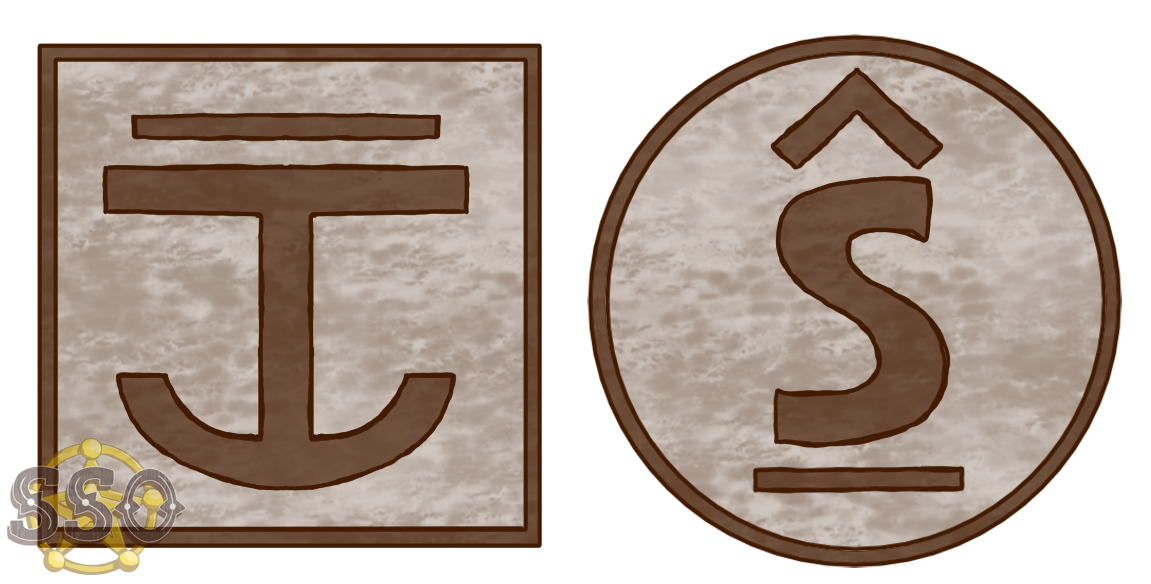
Branding, or iron branding, is a way to mark ownership upon livestock. The most common method of branding is fire iron branding, in which a branding iron is heated via fire and/or hot coals and then pressed onto the animal’s skin in order to make a mark.
In Sand Ocean, the two ranchers - Torito and Shiro - both have their own methods to accommodate for what animals they raise; Torito commonly uses fire branding with an iron, while Shiro uses a special blend of paint-like fluid that washes out of the wool after it is sheared and cleaned.
Usually, normal branding irons pertain to a certain shape, and are combined onto the animal to make a unique pattern that discerns ownership to a person or ranch “company”, such as a “trademark branding”. However, more elaborate brands are designed upfront for Torito and Shiro respectively: the name for Torito's brand is "Box bar rocking T", and the name for Shiro's brand is "Circle rafter S bar".
The Nacklama & Seppodo
In The Star of Sand Ocean, the Yaguchians have certain crafted artifacts that, if enchanted correctly using a special dance ritual, allow the artifact to enable the wearer to communicate with spirits, both those in the afterlife and in the overworld.
There are two artifacts, one of which is Nacklama (pl. Nacklamas). The Nacklama is necklace made of string sourced from hair of a horse's mane, with beads and small bone shards woven in with it. The bones are specifically comprised of rib bones from those that are deceased. The process of extracting rib bones from those that have died is normal for Yaguchians, as securing rib bones ensure that the spirit can be communicated with in the future. The bones that make up part of the Nacklamala are kept in a secure place, buried in a place that all of the tribe knows about that isn't shared with those outside of the tribe.
The second artifact is a dried seed pod from a special plant, called a seppodo (pl. seppodos). The seppodos are made from picking said plant during the late winter, and roasted over a fire. This has to be done carefully as to not let the seed pod catch on fire. The dehydration of the seed pod causes the seeds inside to detach from the ligaments holding it securely in place inside the pod, making them loose artifacts inside the pod. Shaking them around should produce a crisp, rattling noise if done correctly.
There's a very specific way in which these artifacts need to be created and enchanted in order to successfully be able to hear and listen to what said spirits have to say, as well as to allow the spirits to hear what the user has to say. If crafted incorrectly or the usage of the artifacts are incorrect, it simply won't work. Because of this, the Yaguchians keep the process of creating the artifacts as well as the enchantment of said artifacts a secret.
This proves to be an important fact to know, as there are mediums out there that claim to know how to make and enchant the artifacts, and sell random, inauthentic wares to scam customers out of their good money. While there aren't many people out there who would like to communicate with spirits since they know they will join their loved ones when the right time comes, there are enough to allow these scamming mediums to get a good chunk of money off them. Some meduims even trick customers into performing rituals tangential to witchcraft, which is highly illegal and dangerous.
Pearls

Currency is part of a foundation for any society, no matter what form it takes. That should be obvious, considering you use it literally every day.
In The Legendary Starfy games, there are four kinds of pearls that are used as currency in the games, listed in order of value: small pearl; big pearl; small red pearl; and big red pearl. Small pearls are worth one, and big pearls are worth five pearls. Red pearls are the same, with one small red pearl being worth one small pearl. Large red pearls are part of a special mission, and thus don't amount to any kind of certain value.
In The Star of Sand Ocean, the currency used are coins called “pearls”, the name paying homage to the game. With altered colors for a better fit into the world of Sand Ocean, they’re named after their size and new color: the small pearl is “small copper”, the big pearl is “big copper”, the small red pearl is “small silver”, and the big red pearl is “big silver”. The "small gold" and "big gold" are to round out larger currency numbers and are not tied to any kind of pearl whatsoever. In other words, they are completely original.
As printed on the coins: a small copper is one pearl; a big copper is five pearls; a small silver is ten pearls; and a big silver is fifty pearls; a small gold is 100 pearls; and a big gold is 500 pearls.
Puentemuer Paraphernalia
Outdated stuff, this needs to be rewritten!
This entry is not necessarily a tangible object, but moreso something important for the story in itself.
Religion, especially Christianity, was a prominent religion in the upbringing of America and the Old West.
The concept of Christianity is a bit less prevalent in The Star of Sand Ocean. However, there is still a concept of a general religion in which the people of Sand Ocean believe in, those with similar morals to Christianity. Along with this religion comes with taking care of those who have passed on, and paying respects to them and their life. The way in which people help those people are through a ritual that chapel masters perform, called the Puentemuer Ritual.
The Puentemuer Ritual is one that helps the spirit of a deceased person move on into the afterlife. When one dies and is buried, they are subject to a ritual to reveal either one's acceptance or denial of death. The final decision isn't known by the one who performs the ritual, but offers a window for the spirit to move into the afterlife, as they can only do so when the ritual is being performed.
The ritual is a bit of a simple one. It requires reciting a sequence of prayers from a special book along with a string necklace of beads (this is adapted from a ritual the Yaguchians made with the nacklamas to help the spirits rest peacefully).
After it is revealed whether the deceased accepted or denied death, the spirit of the deceased would either ascend into the afterlife to live in peace, or they will remain in the overworld as a spirit. If they remain in the overworld, there are rituals made on set dates on an annual basis that help make sure that the overworld spirits have changed their mind and accepted death to move on into the afterlife. In the meantime, however, they roam the earth, completely invisible to those who are still alive and walking.
More about the spirit aspect of the Ritual is below.
Spirits & Behavioral Things
Outdated stuff, this needs to be rewritten!
The nature of the spirit is a very important one, especially in the context of Native American culture. Similarly, in the general world of The Star of Sand Ocean, spirits are prevalent, and have their own behaviors and states.
When the Puentemuer Ritual is performed, as said, a spirit will either accept death and move on into the afterlife, or they will deny death and remain in the overworld.
There are certain distinctions that help separate the overworld spirits from one another. The first distinction are tethered vs. untethered spirits for those that are in denial of their death. Whether a spirit is tethered or untethered from its body depends on if it had the ritual performed on it. If the ritual has not been performed by someone to the spirit, then it remains tethered to the physical body or any remnants of said body (i.e., skeletal remains, or one's ashes in a burial urn). Those who have been judged at least once become untethered from the body and its site to wander and do what it pleases. Spirits are free to wander, but when they sense that they are being judged again, they naturally return to where their remnants remain, most likely in a cemetery or another organized burial site. They then make the decision as to whether they accept death or remain in denial.
There is a second distinction for those spirits who deny death, which is passive vs. aggressive. Passive spirits mind their own business, and have nonviolent or non-vengeful reasons to deny death, and usually accept death relatively quickly after their first denial of death. Aggressive or haunting spirits are what they sound like. They are spirits that are aggressive and tend to haunt the general vicinity of their burial site, which is usually seen as "paranormal activity" considering the living people cannot see nor hear the spirit, but can feel any interactions the spirit makes with them. They usually take longer to accept death.
The worst form of spirits are vengeful haunting spirits. Vengeful haunting spirits deny death in hopes of satisfying revenge on those who wronged them (or those who feel have wronged them) when they were alive. This can create strange results, which can involve a specific person or group of people to go insane or, on rare occasions, result in death.
Overworld spirits can be dangerous or harmless all depending on their own situation or motives.
On another note, that is slightly unrelated to behavior, is that if and when one can see spirits, they take on an appearance where their cause of death is imminent on their self. For example, if one has been hanged, they will have a noose present around their neck. If they have died from starvation, they will have a hole in their body where their stomach should be, etc. Some appearances might get confused with others, but considering the limited causes of death for characters in The Star of Sand Ocean, this should be an nonissue.
Steam Locomotives
The steam locomotive was one of the most revolutionary inventions of its time. However, they didn’t start out with how you would think they looked. Originally, starting in Europe and the United Kingdom, railroads were built to accommodate wagons that were pulled by horses. Sooner rather than later though, there were advancements and people were able to begin designing engines with steam-powered mechanics, and things went from there.
While the British had their own advancements going on, the United States were doing their own thing as well. Before importing many locomotives from the United Kingdom, there were a few steam wagons that were designed and built to run on the rails that were developed in the country. Mostly after that period, when engines were being imported, there was a manufacturing facility established in the United States, which allowed them to make their own engines domestically. That was when they were made to better fit the system that they had already established within the country.
Within the next fifty years, the locomotive and its innovation was sweeping the nation, as the railroads of the US had stretched all across the country, from the east to the west. This helped in getting supplies from place to place at high speeds compared to that of horses, especially for times like the Civil War. By the time the Civil War had taken place, the industry was already booming. And, even then, a transcontinental railroad had been completed, connecting both sides of the country by railway.
In The Star of Sand Ocean, locomotives are what keep the area alive and moving. However, while there are many trains and locomotives that occupy Sand Ocean’s stretches of rails, there’s one that’s deemed the most important in the scope of the story. And that locomotive is the Shooting Star, operated and managed by Modo and his son, Junior, as a passenger train. It’s a standard locomotive, inspired and modeled after the General Haupt Locomotive, a locomotive named after General Haupt of the US army back in 1863. The Shooting Star operates normally like any other locomotive would and should.
Wanted Posters
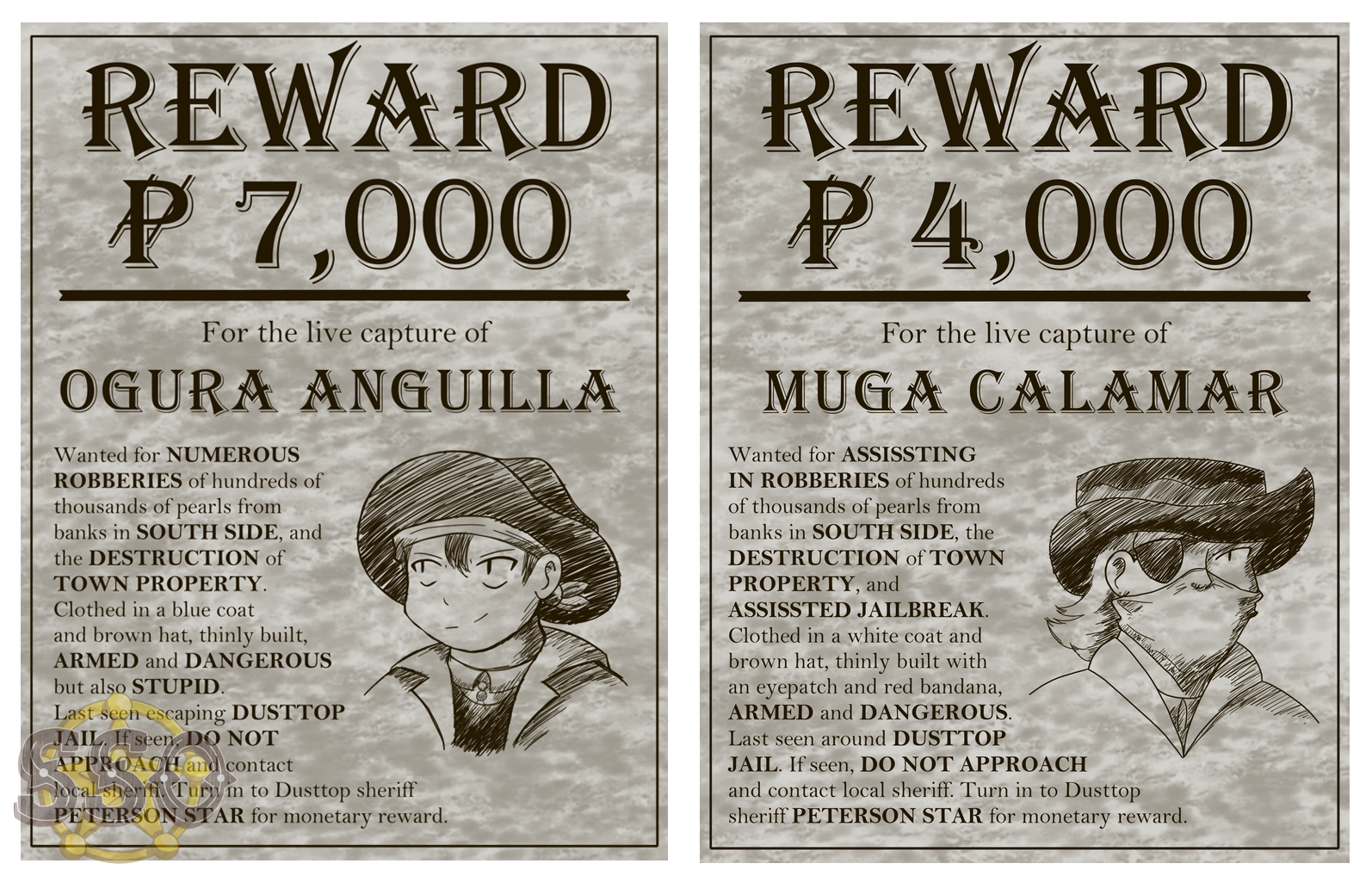
Wanted posters are one of the biggest staples of an Old West setting. These don't warrant much of an explanation considering their straightforward nature. However, contrary to popular belief, wanted posters displayed more than just the reward, the bust of the criminal, and if they were either wanted dead, alive, or both. Posters also included where they were last seen, what they were last seen wearing, and who even warranted the arrest. Multiple iterations are also made to update the bounty and crimes committed, if circumstances warrant such a change. And, more often than not, it does.
In The Star of Sand Ocean, they are widely used, as they should be. The more publicly visible outlaws - that being Ogura and Muga - have multiple iterations of their posters due to updating bounties over time. More low-lying outlaws like Evil only have one. The values presented on these posters depicted for Ogura and Muga are the values that are present for most - but not the entirety - of the story.
The Yaguchian Alphabet
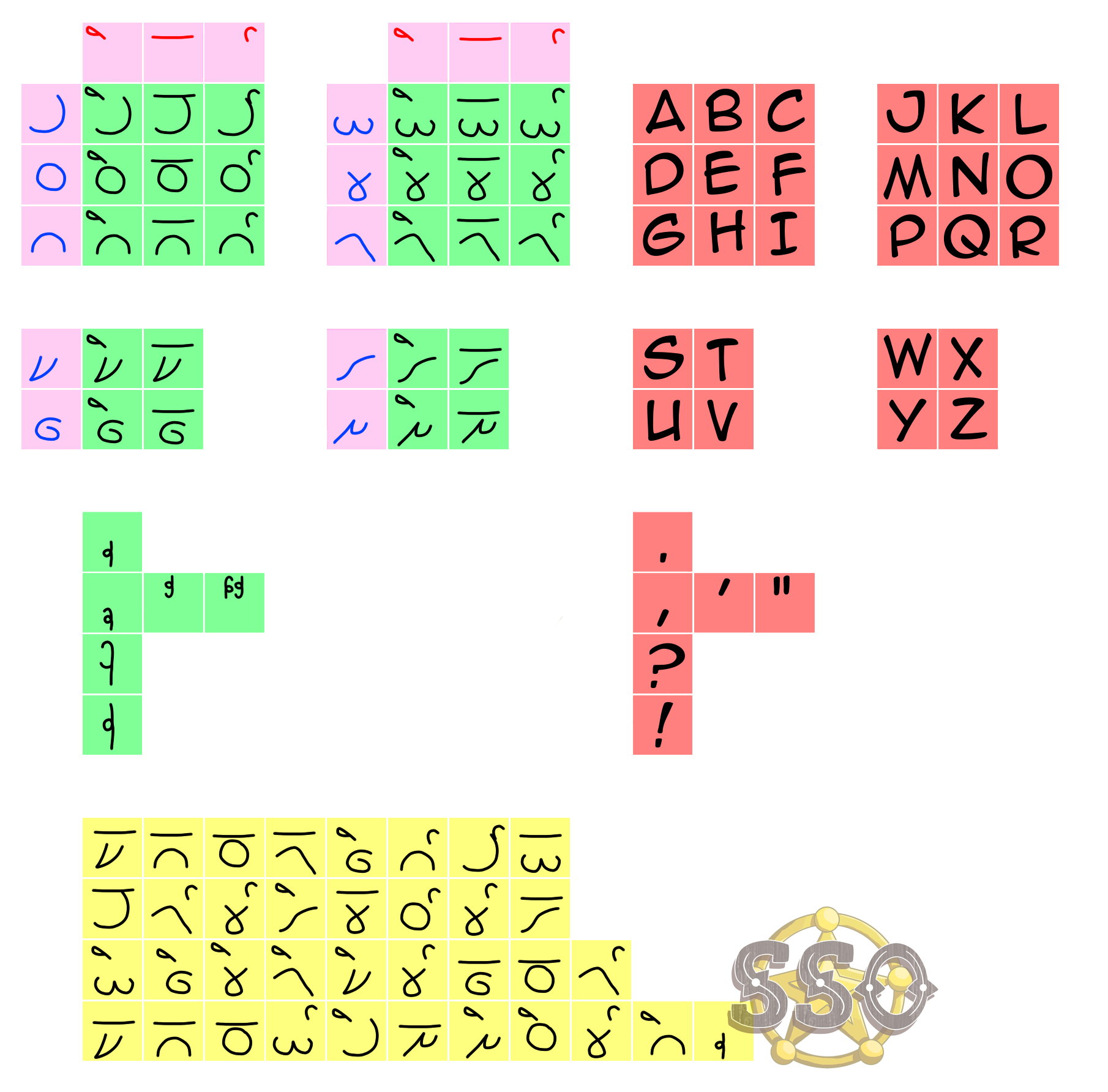
Outdated stuff, this needs to be rewritten!
The language of Native Americans before the arrival of European explorers is a complicated one at that. History has shown that there have been ten or more different language families, and even more languages within those families. It's plausible that a tribe separated by at least a hundred miles would not be able to communicate to one another since their language would be too different from one another. It is also said Native Americans did not have any methods of communication through writing before the arrival of the Europeans.
However, in The Star of Sand Ocean, those who are parallel in nature to Native Americans - the Yaguchians - have their own unique way of writing and communicating: the Yaguchian alphabet.
The symbols of the Yaguchian alphabet are made of two parts, that being the base - written in blue - and the appendage - written in red. There are ten bases, and three appendages. They are combined to create the alphabet. Punctuation also get their own symbols. Unfortunately, standalone bases or appendages don't mean anything unless combined with the other part. It's quite literally writing half a letter.
There is also a certain method of writing that combines the appendages of letters that have like appendages, indicative by column. For example, if more than two letters have the solid line appendage, the appendage will stretch across all the letters. The longest combination of these letters can be up to ten letters at a time, if such word in which that is possible exists. However, if there is a space in between the English versions of these words, then the letters are not connected in this way.
In the manner that spaces work, there really are no spaces in Yaguchian writing. In general, something to keep in mind is to keep the formation of writing as justified in alignment as possible. In the example sentence, it's broken down as "the quick / brown fox / jumps over / the lazy dog." Converting writing to English can be a bit difficult, but the indication of spaces through connected appendages - as explained previously - might help in that regard. This is seen in the example figure, where the appendages of the letters in "The" do not connect with the "q" in "quick". Another indication of the separation of words are punctuation symbols.
If you want to write your own messages with the Yaguchian Alphabet, you should definitely give it a try and send secret codes to your friends!
Last updated: